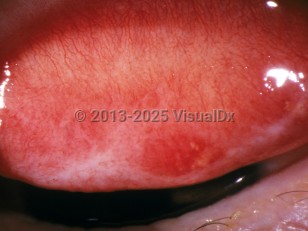Trachoma, also known as granular conjunctivitis or Egyptian ophthalmia, is a bacterial infection of the eye caused by
Chlamydia trachomatis serovars A, B, Ba, and C. The organism is found in eye secretions and spread by direct contact, contact with fomites (eg, clothing), and flies. Trachoma is predominately found in developing countries, particularly sub-Saharan Africa and Asia. The initial infection is frequently acquired before 2 years of age, and recurrent infection causes chronic inflammation with scarring of the cornea, which can lead to blindness if untreated. Worldwide, trachoma is the most preventable cause of infectious blindness.
Clinical manifestations of trachoma can be divided into 2 clinical phases: active trachoma and cicatricial disease.
Active trachoma – Active trachoma is mostly seen in young children and occurs after a 5-10 day incubation period from exposure. While most individuals are asymptomatic, signs and symptoms can include the following:
- Swelling of the eyelids from formation of follicles on the superior tarsal conjunctiva
- Eye irritation
- Mucopurulent discharge
Cicatricial disease – The later stage of trachoma, known as cicatricial disease, is secondary to repeated episodes of infection and is mainly seen in adults. Clinical features include the following:
- Marked conjunctival inflammation
- Entropion – Conjunctival scarring leading to inward turning of the eyelid
- Trichiasis – Ingrown eyelashes from entropion causing irritation of eyeball and cornea
- Corneal edema, ulceration, and scarring due to trichiasis, resulting in corneal pannus (inflammatory vascular tissue) followed by corneal opacity, and eventually blindness



